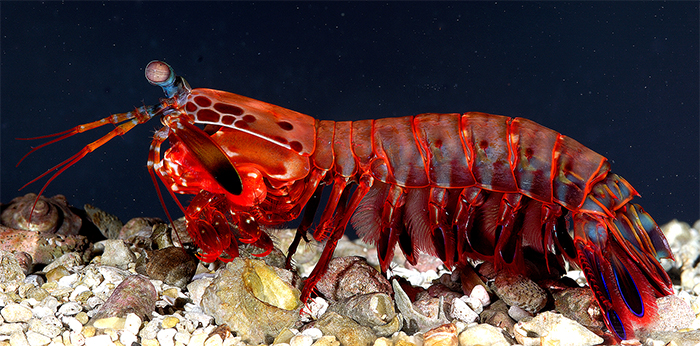
Researchers are now studying the invincible material of mantis shrimps' dactyl clubs for impact resistant solutions.
An unassuming but mighty crustacean is being studied for possible armor wear. Endemic to tropical shallow waters throughout the world, the mantis shrimp—known as “thumb-splitters”—possess a powerful truncheon that can even crack a pane of aquarium glass. Having rightly earned its moniker, at least one man had his finger amputated after a strike from this small creature.
There are two types of mantis shrimp lurking in sea floors, “spearers” and “smashers.” The spearers skewer prey with a fiercely pointed claw, but smashers use their invincible appendage to shatter anything they can to get food. Their clubs are technically called dactyl clubs, which are the focus of analyst’s studies a Washington Post report indicates.
How the small crustacean is able to deliver such a blow has been a source of inquiry. Scientists at the University of California at Riverside previously found that the inner layer of the shrimps’ dactyl club is made of a corkscrew pattern of chitin—the material of insect shells—surrounded by areas made of hydroxyapatite, the material that constitutes human teeth.
According to new research presented in the journal Advanced Materials, the UC-Riverside scientific team has discovered a formerly unknown native structure existing in the outer layer, the “impact area,” of the appendage made of herringbone. Investigators surmise that when the shrimp strike at hard surfaces, such as a shell, the occurring herringbone wave buckles, which disperses the impact throughout the club without shattering its arm or its prey’s shell.
David Kisailus, a UC-Riverside chemical engineer and author of the paper, said in a statement that “The smasher mantis shrimp has evolved this exceptionally strong and impact-resistant dactyl club for one primary purpose — to be able to eat.”
With these new records, scientists have printed a 3-D prototype helmet that mimics the dactyl club’s structure.
“The more we learn about this tiny creature and its multi-layered structural designs,”said Kisailus, and, “the more we realize how much it can help us as we design better planes, cars, sports equipment and armor.”
Image credit: Wikipedia Commons Public Domain

Leave a Reply